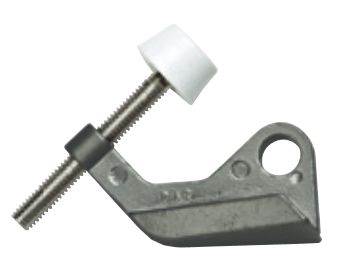 I’ve written specifications for many projects where the architect requested hinge-pin stops – door stops which mount on the hinge pin and are designed to stop the door when it reaches the desired open position. In theory, these stops are great…no prep is needed in the wall or floor, there is no tripping hazard, and they’re almost invisible compared to the other options.
I’ve written specifications for many projects where the architect requested hinge-pin stops – door stops which mount on the hinge pin and are designed to stop the door when it reaches the desired open position. In theory, these stops are great…no prep is needed in the wall or floor, there is no tripping hazard, and they’re almost invisible compared to the other options.
BUT, I’ve had enough problems over the years that I began fighting hard to avoid using hinge-pin stops except inside of residential dwelling units, and even with dwelling units I only used them when I absolutely had to.
I was recently asked about using hinge-pin stops on a health-care facility, because the hospital prefers hinge-pin stops rather than overhead stops. While it’s true that overhead stops cost more initially, they are a heavy-duty product that will hold up better over time (IMO).
- Do you have a strong preference one way or the other – hinge-pin stops or overhead stops?
- If you do use hinge-pin stops, what are the conditions/locations where you prefer to use them?
- If you don’t use hinge-pin stops, why not? Is there any documentation that would help support one type of stop or the other?.
WWYD?
You need to login or register to bookmark/favorite this content.





We’ve done a number of hotels that request them in the guest rooms. They like the Don-Jo 1512. It comes with its own pin and is less visible than the type in your photo. We did notice that the pin has a tendency to rise over time so now we provide an NRP hinge at the top and use the set screw to keep that pin in place.
I’ve always specified NRP butts for healthcare, so hinge-pin stops have been a moot point. Most spaces don’t have much issue placing either a floor or wall stop if an OH stop is not desired.
Bryant – I’m curious why you always specify NRP hinges at healthcare facilities? I’m assuming you’re referring to interior doors and only doors that swing out. However, have you ever tried to remove a locked door from an opening by removing the hinge pins? It’s not easy. If you add a closer to the equation, it’s nearly impossible. I’ve seen requests for NRP hinges in hospitals and question this every time. Hospitals are typically open/operational 24/7. I can’t imagine anyone being able to successfully opening a locked door by removing the pins without drawing a LOT of attention to themselves.
I’m not arguing against your procedure, just curious why you do it. Maybe there’s something I haven’t thought about.
For commercial I will always default to the overhead stop over the hinge pin stop. But that said there are instances where a hinge pin is the only means to stop a door when it needs to be. I’ve detailed jobs where an opening such as a locker room changing door has a one foot under and over cut and opens into locker so a overhead stop, wall stop, and floor stop are all inapplicable.
I don’t like both of them but never allow hinge stop.
I have no location I would allow them unless it was a real low end use like a frat.
I don’t know any other documents but have my own design guide for the university.
The few places that I could not use a floor or wall stop I just use a closer with back check set right or if I need a more dead stop I will use a cush arm.
I agree with John, I am not a fan of either overhead or hinge stop. A hinge stop would be out of the question, not allowed. I will at times allow an overhead stop but we have had so many doors and frames torn apart by overhead stops we just use closer backcheck when a floor or wall stop does not make practical sense.
Keith
Who makes a hinge pin stop, like the one pictured above, that fits commercial hinge pins? I get asked about these frequently but I don’t have a source for them. Although I tell the architect/GC/owner that just because they work on your hollow core bathroom door at home doesn’t mean they will work on a 100+ lb commercial door. No more than the residential springy projection stops that make the funny noises.
Hinge pin stops are the worst. The amount of force exerted on the door and frame is huge. I’ve seen more than one 16 ga. hollow metal frame with a dimple. They also seem to break on a regular basis and, with hollow core residential doors, they can punch right through the door face. I’ve seen them specified on hotel suite entry doors, which are fire rated, and have always worried that it would somehow void the fire rating because the hinge has to be “modified” to install them. However, I’ve never found anything to back this up (or confirm that it’s acceptable). I always discourage their use.
I hate the rotten things. When I worked residential I avoided specifying them if at all possible. I have seen hinges ripped right out of frames from the leverage hinge stops create. I would even fit Ives 404 stops on door faces where they would come into contact with toilets, tubs etc. They don’t look good but they look better than a damaged door. Now that I do hardware for schools I don’t even consider hinge stops They would last all of 15 minutes in that environment. Cush closers are my go-to as even GJ overhead stops have a limited life span in the schools. For exterior doors we sometimes even have to resort to bollards to limit door swing.
Overhead stops first and foremost.
There is a hinge pin stop that is actually pretty well made and works well.
Can’t remember who makes it off the top of my head.
It’s a lil more costly, but worth it.
I’ve never seen a hinge pin door stop that was suitable for commercial applications. Most are light weight die cast pot metal, rather easily broken; and as such restricted to residential work in IMHO.
Pete Schifferli
I fail to understand the folks who fail to understand the simple physics of a 125# door 36” wide levering against a less than 2” part. Minimum 18 to 1 advantage or a ton of force against and through the entire door-hinge-frame assembly. I never use them.
What Bryan McKeehan said. They were a bad idea and are a bad idea. Find a way to stop the door at the edge not the hinge.
Is this topic of stops and all the comments printable, we have at least one architectural firm here that needs to see this. They feel the appropriate hardware at a classroom door, sans closer, is a hold open type of medium duty overhead stops where a wall stop was used in earlier phases of the same school and same architect. Masters and monsters of copy and paste.
Hi Bryan –
Yes, you should be able to print the post and comments.
– Lori
IMO, hinge pin stops aren’t a good application in residential much less commercial environments. Any device that puts additional stress on the top hinge (which hinge pin stops do), is a bad idea. They break down the reinforcements in both the door and frame, causing the door to sag. Not to mention the physics pointed out by earlier responses….